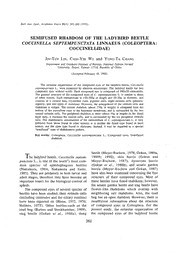
SEMIFUSED RHABDOM OF THE LADYBIRD BEETLE COCCINELLA SEPTEMPUNCTATA LINNAEUS (COLEOPTERA: COCCINELLIDAE) PDF
Preview SEMIFUSED RHABDOM OF THE LADYBIRD BEETLE COCCINELLA SEPTEMPUNCTATA LINNAEUS (COLEOPTERA: COCCINELLIDAE)
Bull. Inst. Zool., Academia Sinica 31(4): 261-269 (1992) SEMIFUSED RHABDOM OF THE LADYBIRD BEETLE COCCINELLA SEPTEMPUNCTATA LINNAEUS (COLEOPTERA: COCCINELLIDAE) Wu and JIN-TUN LIN, CHIN-YIH YUNG-TA CHANG Department and Graduate Institute of Biology, National Taiwan Normal University, Taipei, Taiwan 11718, Republic of China (Accepted February 10, 1992) The retinular organization of the compound eyes of the ladybird beetle, Coccinella septempunctata L., were examined by electron microscopy. The ladybird beetle has two compound eyes without ocelli. Each compound eye is composed of 980±50 ommatidia. The general structure of the compound eyes of C. septempunctata L. is similar to those of other insects. Each ommatidium is 150-200~ in length and 20-30~ in diameter, and consists of a corneal lens, crystalline cone, pigment cells, eight retinula cells (photore ceptors), and two types of rhabdoms. However, the arrangement of the retinula cells and rhabdoms is unique. The central rhabdom (about 170~ in length) is elongated from the bottom of the crystalline cone to the basement membrane, and is surrounded by the two central retinula cells. The peripheral rhabdom is short (about 10~ in length) in the distal layer only; it encloses the central cells, and is surrounded by the six periphe~al retinula cells. The rhabdomeric construction of the ommatidium of C. septempunctata L. is very different from those found in other insects; it is neither the fused type found in most insects, nor the open type found in dipterans. Instead, it may be regarded as a special "semifused" type of rhabdomeric pattern. Key words: Coleoptera, Coccinella septempunctata L., Compound eyes, Semifused rhabdom. beetle (Meyer-Rochow, 1978; Gokan, 1989a, o The ladybird beetle, Coccinella septem 1989b; 1990), skin beetle (Gokan and punctata L., is one of the world;s most com Meyer-Rochow, 1987), dynastine beetle mon species of aphidophagous beetles (Gokan et al., 1986b), and asiatic garden (Nakamuta, 1984; Nakamuta and Saito, beetle (Meyer-Rochow and Gokan, 1987) 1985). They are predatory in both larval and have also been examined concerning the fine adult stages, therefore they ohave become an structure of their compound eyes. Most -of important insect for the biological control of these beetles have fused rhabdoms; however, aphids. the asiatic garden beetle and stag beetle have The compound eyes of several species of flower-like rhabdoms which overlap with beetles have been studied, their retinula cells neighboring cell rhabdoms. Also, the toad (inCIudipg centrioles and the ciliary rootlets) bug has an open rhabdom. However, there is have been reported on (Home, 1972, 1976; insufficient information about the structure Bolmes, 1975). Other beetles-such as the of compound eyes in Coleoptera. For the toad bug (Burton and Stockhammer, 1969), present study, the retinular organization of stag beetle (Gokan et al., 1986a), dung the compound eyes of the ladybird beetle 261
